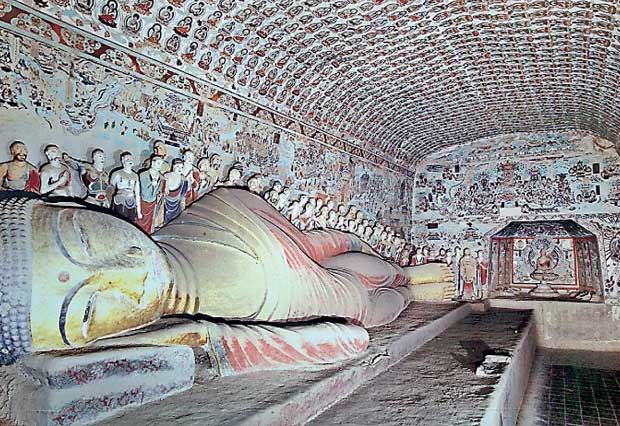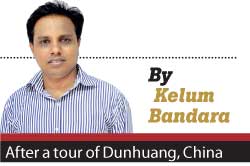Reply To:
Name - Reply Comment
Last Updated : 2024-04-20 09:22:00

 China is featured in the world media over its Belt and Road Initiative, a project primarily associated with international trading in today’s context. Little is known about the fact that the ancient Silk Route that ran across Dunhuang, China served the crosscurrents of people and cultures giving birth to the Buddhist heritage site called Mogao Grottoes.
China is featured in the world media over its Belt and Road Initiative, a project primarily associated with international trading in today’s context. Little is known about the fact that the ancient Silk Route that ran across Dunhuang, China served the crosscurrents of people and cultures giving birth to the Buddhist heritage site called Mogao Grottoes.
Located around 25 kilometres off Dunhuang, Mogao caves, which speak volumes about the rich Buddhist heritage of China, evolved due to encounters with the Indus Valley civilizations through the ancient Silk Route.
The UNESCO listed the Mogao Caves as a world heritage site in 1987. Since then, China has placed the site as a high protection site. In fact, even today photography is not allowed inside the caves as flashlights of cameras can damage the historic murals and paintings
Nestled in the middle of the Gobi Desert and carved into the eastern side of Mingsha Mountains, is a long line of caves, whose walls bear numerous Buddhist murals, sculptures and statues.
The network of caves, commonly called Mogao Grottos, is now a world heritage site declared by the UNESCO.
Last month, China conducted its International Media Forum on the Belt and Road Initiative in Dunhuang, which is home to this Buddhist heritage site. It seems that the heritage site, preserved to be faithful to its original texture of murals and art works, is now used as a powerful tool of culture diplomacy played by China for fostering ties with the rest of the world in the modern context.
Dunhuang is an oasis of the Gobi Desert bordering Inner Mongolia on one side and Tibet on the other. Despite bright sunshine, the cool breeze across the desert terrain, marked by sand dunes and caravans of camels, ensures comfortable tourism for visitors today.
Carved into the mountain cliff, there are 492 caves in the Mogao Grottos housing over 2,000 sculptures and about 45,000 square metres of murals.
According to travel guides, the Mogao Grottos are divided as the Southern and Northern areas.
The Northern area comprises 243 caves used for religious practices and as living quarters of monks. Like in ancient Sri Lanka, Buddhism, which travelled to China from India along this ancient silk route, enjoyed the maximum possible patronage from the rulers of various Chinese dynasties.



They appeared to have considered it as their foremost duty to patronize the building of the places and objects of Buddhist worship. Inscriptional evidence suggests, as transpired during briefings by our travel guides, that the first cave of Mogao Grottos was built by monk Le Zun in 366AD. Afterwards, the cave constructions continued for ten dynasties starting from Northern Liang.
Along with Buddhist work of art, tourists also find paintings of camels pulling carts, vividly describing the mode of trade during the ancient era along the silk route that connected Gansu Province with Central Asia in principle at that time.
Geographically speaking, the Silk Road had been the confluence of two main cultivations at that time.
Dunhuang had been an intersection along the Road. As such, it offered an avenue not only for trading in goods but also for cross cultural exchanges at that time. It finally influenced the development of a unique Chinese tradition of art with imprints from the rest of the Buddhist world at that time.
The images, depicted in the caves built during the Northern Liang and Northern Wei Period, show the Buddha in Samadhi. The image-making culture has evolved over the following years in terms of techniques adopted for the depiction of Jataka Stories associated with the Buddha’s life.
A major attraction is the 34.5 metre tall Buddha statue. Its construction started during the Tang dynasty in 695 AD. Later, it had been developed further and further during the reigns of other dynasties that followed.
Last month, China conducted its International Media Forum on the Belt and Road Initiative in Dunhuang, which is home to this Buddhist heritage site. It seems that the heritage site, preserved to be faithful to its original texture of murals and art works, is now used as a powerful tool of culture diplomacy played by China for fostering ties with the rest of the world in the modern context.
It is said that Empress We Zetian took steps in the construction of Dayun Temple in every prefecture. This Cave, housing the image of Maitreya Buddha, is considered to be the ancient Dayun Temple.
Another major attraction is Cave 148. It houses the Buddha in Nirvana posture. It had been built in 776 AD. Illustrations on the walls of this particular cave describe different Suttas including Mahaparinibbhana Sutta.
The UNESCO listed the Mogao Caves as a world heritage site in 1987. Since then, China has placed the site as a high protection site. In fact, even today photography is not allowed inside the caves as flashlights of cameras can damage the historic murals and paintings.
Not only that, the number of visitors per day is restricted to 6,000 as otherwise their inhalations and exhalations inside the cave chambers could also be harmful to the walls bearing works or art. High-tech sensor devices have been installed to monitor moisture and temperature level constantly for better preservation.

The site has gone through several cycles of damage and restorations.Some parts of paintings have been vandalised probably during times of invasion by those of different faiths.
China selected Dunhuang, the city of Mogao Grottoes, to host over 400 media personnel representing 126 countries and organisations in view of the International Media Forum on the Belt and Road Initiative. That is apparently to put China’s vision in perspective in a historical context.
China has digitised the site. In a state-of-the-art theatre, visitors can watch the filmed versions of ancient murals, paintings and statues on digital screens for greater understanding of history.
Monk Xuanzang inspired Mogao art Also available are specially designed films showcasing ancient China. Visitors, again, are entertained with scenes describing how Gansu Province or Dunhuang for that matter prevailed at that time both as a trading spot and hotspot of invasions.
There are scenes of caravans of camels, carrying items such as silk, ceramic and tea on the one hand. On the other hand, caravans are found to return with items such as gold and gems from the other side of the world in Central Asia.
Swirling sandstorms and sword-wielding bandits on horseback are menacing. Amidst all that, come Buddhist monks on religious missions on the ancient Silk Route.
Xuanzang is one such Buddhist monk who arrived along the silk route carrying Buddhism to China. So, the ancient silk route not only served the purpose of cross-border trading of items of valuable ceramic, tea, gems and gold, but also spread the message of the Buddha across the Central Asian region to China from India.
Dunhuang is the oasis in which Xuanzang stopped. He translated Buddhist suttas. It inspired the new form of Buddhist art now visible on the walls of Mogao Grottos in the form of Buddha statues in different postures, celestial musicians, and ancient merchants. In history, the site has witnessed periods of abandonment. In 1900, a Taoist monk happened to discovered first cave.

Add comment
Comments will be edited (grammar, spelling and slang) and authorized at the discretion of Daily Mirror online. The website also has the right not to publish selected comments.
Reply To:
Name - Reply Comment
On March 26, a couple arriving from Thailand was arrested with 88 live animal
According to villagers from Naula-Moragolla out of 105 families 80 can afford
Is the situation in Sri Lanka so grim that locals harbour hope that they coul
A recent post on social media revealed that three purple-faced langurs near t